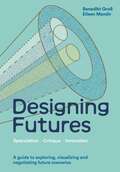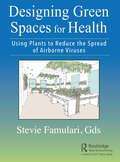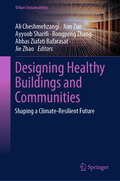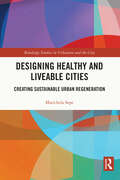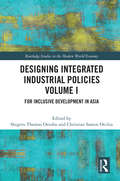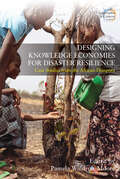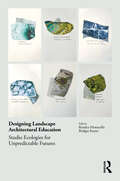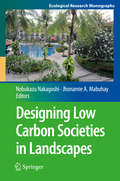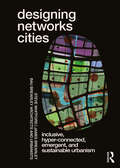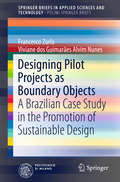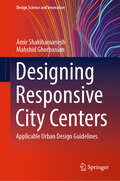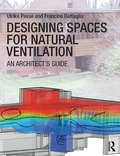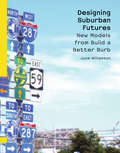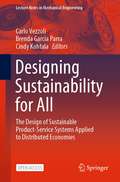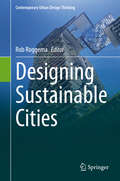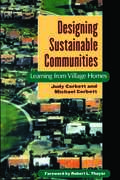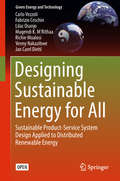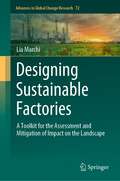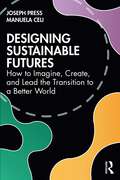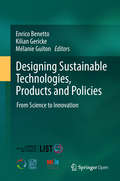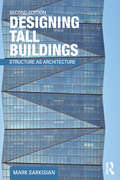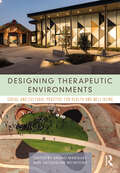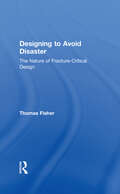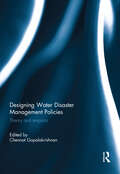- Table View
- List View
Designing Futures: Speculation, Critique, Innovation
by Benedikt Groß Eileen MandirThe ability to imagine different possible futures and the will to influence the course of events are deeply human. These ideas about the future can also determine which of the many possible futures will become reality. Designing futures therefore means that by creating and communicating potential scenarios, you can shape the futures of your fellow human beings and influence the course of events. Design is becoming more strategic as a discipline, moving away from 'making things beautiful' to 'thinking creatively'. This book provides designers with the methods and tools they need to develop discussable and tangible scenarios. It also outlines ways for creative people, activists and decision-makers in politics, science and the wider society to imagine more desirable futures.- With over 500 illustrations.- Case studies from across the world.- Foreword by Riel Miller, senior fellow at the École des Ponts Business School, the University of Stavanger and the University of New Brunswick.
Designing Green Spaces for Health: Using Plants to Reduce the Spread of Airborne Viruses
by Stevie FamulariThis book focuses on using plants in spatial design to reduce the infectiousness of viruses in different working and living spaces. It presents strategies for interior and exterior green designs with plants that are likely effective for flu virus tolerance and reduction of infectiousness. The designs are appealing for interaction and healing, as well as focusing on the reduction and removal of virus infectiousness. The Famulari Theory requires examining plants that are likely effective for virus accumulation based on their leaves with stomata, trichomes, and dense leaf growth, and transpiration rate accumulation of airborne viruses. In addition, this research requires reviewing the quantity and specific types of plants (as well as electronic sources, such as humidifiers and water features) needed to produce effective humidity for plants to decrease the infectiousness or transmission of viruses; the effective distance of people to plants; and light, water, soil, and temperature needs. The book addresses the various greening practices that can be applied to sites to reduce the infectiousness of the airborne flu virus – especially in areas such as train stations, restaurants, rooftops, courtyards, office buildings and work spaces/conference rooms, and the home office – and the ways that businesses owners and residents can integrate these practices to reduce the air contaminants with a green solution. Designing green spaces that accumulate, reduce, and remove the infectiousness of viruses involves exploring multiple approaches from different directions to achieve the most effective and ideal design. The six basic approaches include 1. Temperature minimum of 70° Fahrenheit 2. Plants with multiple stomata on the leaf surfaces 3. Plants with multiple clumps of dense leaves with a high transpiration rate 4. Plants with rough leaf surfaces or with trichomes (plant hairs) on the leaf 5. Relative humidity (RH) minimum of 43% or higher 6. Air circulation to direct air with the airborne flu virus to the planted areas Stevie Famulari brings unique insights and inspires the development of green understanding and design solution plans with both short-term and long-term approaches. Illustrations of greening applied to locations help you understand your own design solutions to create them in your site. This book breaks down the misconceptions of the complexity of sustainability and green practices and provides illustrations and site-appropriate green solutions that you can incorporate into your lifestyle for a healthier site. Greening is a lifestyle change, and this guide lets you know how easy it is to transition to the green side to improve your health.
Designing Healthy Buildings and Communities: Shaping a Climate-Resilient Future (Urban Sustainability)
by Jian Zuo Ali Cheshmehzangi Ayyoob Sharifi Rongpeng Zhang Abbas Ziafati Bafarasat Jie ZhaoThis book aims to explore and showcase global case studies focused on creating buildings and communities that promote health while enhancing climate resilience. In an era where climate change increasingly impacts urban environments, there is a critical need for innovative solutions that go beyond conventional practices. This book compiles a diverse range of examples, drawing on real-life projects and potential paradigm shifts that emphasise novel ideas and advanced methodologies. The featured case studies span various aspects of building and community design, including architectural design directions, technology integration, and technical methods. Each contribution provides practical examples that illustrate the implementation of these concepts in real-world settings. By highlighting innovative approaches, the book challenges the status quo and encourages a shift from business-as-usual scenarios to forward-thinking strategies that prioritise both human health and environmental sustainability. Key themes include the integration of green building technologies, the adoption of sustainable materials, and the incorporation of nature-based solutions in community design. Additionally, the book delves into community-driven initiatives that foster social cohesion and climate-resilience, demonstrating how collaborative efforts can lead to more robust and adaptable cities. Through detailed analyses and comprehensive discussions, this book serves as a vital resource for architects, urban planners, policymakers, and researchers. It provides insights into cutting-edge practices and offers inspiration for future projects aimed at creating a healthier and more sustainable future. By bringing together these global perspectives, the book highlights the importance of innovation and adaptability in the face of climate challenges, ultimately contributing to the development of sustainable and thriving urban landscapes.
Designing Healthy and Liveable Cities: Creating Sustainable Urban Regeneration (Routledge Studies in Urbanism and the City)
by Marichela SepeIn the last ten years, concepts such as urban health and liveability have become ever more present in urban planning studies. Many companies rank the most liveable city in the world or in a nation, and many indicators are used to try to measure factors which can report the health of a place by investigating it in different ways. While it is possible to understand why a place is liveable – due to the liveability and health concepts that are being more and more explored in urban studies, and the strong influence coming from other disciplines – it is difficult to design a place that is certain to be healthy and liveable. Accordingly, aim of this book is, after the definition of the field of investigation concerning sustainable regeneration trough topics such as resilience, adaptation, health, and mixed connections, to illustrate the present-day approaches to the analysis and design of healthy places, and in particular the original Healthy Pl@ce Design method, flexible and repeatable in different contexts. The method aims to identify sustainable urban liveability and healthiness and the factors which make places liveable and healthy from users' points of view and identifying design interventions that can enhance or create both urban liveability and health. Emblematic case studies carried out in Europe, Canada and China – Bordeaux, Copenhagen, Hamburg, Madrid, Newcastle–Gateshead, Nice, Dublin, Vancouver and Wuhan – constitute the empirical part of the book, detailed with surveys, questionnaires, images and maps. The theoretical framework – built on contemporary issues – and international case studies make this book both attractive and scientific, adding a new stone on the sustainable city construction and opening it to a particularly wide readership, including scholars, students, administrators and professionals.
Designing Innovative Corporate Water Risk Management Strategies from an Ecosystem Services Perspective
by Emily Taylor Berry Kennedy Don Scavia Makely Lyon Joshua Rego Daniel Gerding Andrew Hoffman Neil HawkinsAccess to water is essential for almost all aspects of the economy and quality of life; in particular, for health, food production and security, domestic water supply and sanitation, energy, industry, and ecosystem health. Yet, water scarcity already affects more than 40 percent of the global population, and by 2025, it is estimated that and two-thirds of the world’s population will be living in regions where water supplies are stressed and 1.8 billion people will be living in countries or regions with absolute water scarcity. By 2030, it is estimated that 47 percent of the global population will be living in high water stress areas. The authors of this book survey common organizational (both public and private) responses to water scarcity across three categories--technology-based, policy-based, and management-based--and then focus on the latter as holding the most promise for creating a robust, organization-wide solution for potential freshwater scarcity. Management-based responses are those developed within the organization to internalize water-related externalities.
Designing Integrated Industrial Policies Volume I: For Inclusive Development in Asia (Routledge Studies in the Modern World Economy)
by Shigeru Thomas OtsuboThis comprehensive reference work gives an overview of the industrial development and current state of industrialization and deindustrialization in Asia, specifically Southeast Asia and China. It introduces typologies of industrial policies and discusses the manufacturing sector and its evolving role in the region. Designing Integrated Industrial Policies examines the integration of SMEs in global value chains and provides macro-econometric and firm-based micro-econometric analyses of (de)industrialization. This book will be a very useful reference particularly as a how-to guide on industrial promotion and designing integrated industrial policies not only for economic growth and job creation but also for "inclusive" development. It presents country cases and illustrates useful tools for industrial policy simulation and for evidence-based policy making through these concrete examples.
Designing Knowledge Economies for Disaster Resilience: Case Studies from the African Diaspora (Catastrophes in Context #7)
by Pamela Waldron-MooreDisaster research has been studied from many angles, seldom targeting its implications for vulnerable territories in Africa. Entities most subject to the effects of climate change are often undeveloped and located in disadvantaged regions. Post-disaster communities need to scrutinize the social, political, economic, and cultural structures that stagnate sustainable growth. Acknowledging that low economic development and high climate costs cannot coexist, this collected volume interrogates the challenge for disaster-prone territories to determine strategies for restructuring and redesigning their environment. This book proposes the creation of knowledge economies, whereby empowered communities may produce innovative knowledge translatable across the African diaspora.
Designing Landscape Architectural Education: Studio Ecologies for Unpredictable Futures
by Rosalea Monacella and Bridget KeaneNo single project or endeavour is immune to the issues that the climate crisis brings. The climate crisis encompasses a broad register of "symptoms" – increased global temperatures and sea-level rise, droughts and extreme bushfire events, salinification and desertification of fertile land, and the list goes on. It reveals and amplifies complex causal relationships that are inherently present and traverse scales, sectors and communities divulging a range of impacts and inequalities. This publication asks designers and academic practitioners to describe their own work through an ecological lens, and then to articulate design approaches for developing new practices in landscape architecture teaching. Designing Landscape Architectural Education: Studio Ecologies for Unpredictable Futures, the Landscape Architecture Design Studio Companion, serves as a resource for academic practitioners in the preparation and delivery of "design-research studios" and students seeking guidance for design methodologies as a part of their landscape architectural education. It draws on the manifold issues of the climate crisis as a set of drivers to examine the utilisation of a range of innovative design approaches to address the current and future priorities of the discipline. The landscape architecture discipline is evolving rapidly to respond to both a broadening and intensification of changes in the environmental, social and political conditions. These changing conditions require innovation that extend the core competencies of landscape architects. This book addresses two fundamental questions – what are the design competencies required of landscape architects to equip them to deal with the complexities brought forth by contemporary society, and as a result, how could we design the future design studio?
Designing Low Carbon Societies in Landscapes
by Nobukazu Nakagoshi Jhonamie A. MabuhayThis book focuses on three major means of achieving a low carbon society: conservation of the ecosystem complex, changes of arrangement of landscapes, and creation of biodiversity. There are specific countermeasures to be taken for carbon absorption in the three types of landscapes--urban, cultural, and natural--because their carbon balances differ. Urban landscapes are promising sites because they have the potential for greening and the creation of biodiversity. Cultural landscapes in the tropics had not been actively researched until recently, but this book now presents a collection of several cases focused on those areas. Natural landscapes had existed in abundance in developing countries; later, nature protection areas were designated to coexist with development. Now, however, developmental pressure has penetrated into those nature protection areas, and landscape ecological projects are urgently required to preserve them. As a result of global warming, abnormal weather phenomena including super typhoons have occurred frequently in recent years. The major underlying cause is the higher concentration of greenhouse gases released by human activities. As well, major natural absorbers of CO2 such as forests, wetlands, and coral reefs are shrinking, and the human impact is causing the ecological balance to deteriorate. Controlling CO2 emissions and expanding the CO2 absorbers are keys to reducing total CO2. Low carbon societies can be established by maintaining the original CO2 balance through integration of multiple tools, with contributions from diverse fields such as physics and chemistry, physiology and humanities, and education. On the basis of an international consensus, the environment must be protected no matter what sacrifices are required. As this book demonstrates, achieving a low carbon society is a top priority, and landscape conservation is the first step in ecological research toward that goal.
Designing Networks Cities: Inclusive, Hyper-Connected, Emergent, and Sustainable Urbanism
by Steve Whitford James Brearleydesigning networks cities presents a sophisticated, multi-disciplinary, and multi-dimensional approach to urban design. Emerging from years of practice, experimentation, and research by designers (landscape architects, urban planners, urban designers and architects), this approach engages with contemporary thought across a number of disciplines to re-invent the entrenched blunt instruments of the city making process. A cry for flexible, sharp-instruments in urban design, designing networks cities presents a multi-dimensional way of seeing the essential components of the city (form, space-time, order and aesthetics). It purposefully links traditional architectural design derivation mechanisms to urban design, in the hope that cities will not only be pragmatic, but also become sophisticated iconographically, poetically, and syntactically. It provides the tools to enable decision making within a multiplicity of constraints and opportunities: a philosophy of becoming, not being; a science of dynamic systems, not stasis; and an art of sensations, not subjectivity. And finally, and most importantly, it argues why it is important that cities embrace these multiple dimensions of society on a planet that is facing increasing environmental challenges: an economics focused on equity for all, not for some more than others; a politics supporting a genuine representational democracy, not one representing the overly influential; and a culture [including history] that embraces difference, not one that encourages division. designing networks cities not only provides the means to identify these issues and a methodology to deal with them within a complex emerging co-existence, but also demonstrates the development of cities that embrace and respond to the complexities of life in what some are calling the Anthropocene.
Designing Pilot Projects as Boundary Objects
by Francesco Zurlo Viviane dos Guimarães Alvim NunesThis book describes a collaborative Design Pilot Project held in Brazil (called MODU. Lares) involving micro and small enterprises and other actors in the furniture sector. The experience was based on an action research method and evaluated by using a tool, in order to assess the value of pilot project as a boundary object capable of fostering innovation and sustainability. The impact of the Design Pilot Project in triggering change in a fragmented local system with a poor environmental and social record, as well as management and innovation issues, were assessed with the help of the same tool, taking into account environmental, technological, economic, sociocultural, and organizational indicators. The collaborative network established was chiefly based on four elements: prototypes, meetings, exhibitions and the Pilot Project (as an overall process). The results indeed demonstrate that a Design Pilot Project can be a valid instrument for establishing a collaborative environment that promotes sustainability and innovation, particularly in contexts with a weak associative culture. Such collaborative projects can constitute the first step in a design policy cycle in developing countries, contributing to the definition of ideas and objectives among local stakeholders, minimizing the risks of failure, and increasing the chances of receiving governmental support.
Designing Responsive City Centers: Applicable Urban Design Guidelines (Design Science and Innovation)
by Amir Shakibamanesh Mahshid GhorbanianThis book explores the history and evolution of city centers and provides practical guidance for designing successful city centers, emphasizing the importance of urban design guidelines in achieving this goal. With a focus on community engagement, environmental quality, and economic benefits, the book offers a roadmap for creating vibrant, dynamic, and sustainable city centers that enhance the overall quality of life for their communities. The book offers guidelines for urban design, which can be used to apply the main principles and solutions related to landscaping, building architecture, and access systems. The guidelines manifest development policies as key solutions and govern the qualitative aspects of the plan, enabling the creation of responsive city centers that benefit their communities. An invaluable resource for anyone interested in urban design and its role in shaping the cities of the future, this book is an essential tool for creating successful and sustainable urban environments.
Designing Spaces for Natural Ventilation: An Architect's Guide
by Ulrike Passe Francine BattagliaBuildings can breathe naturally, without the use of mechanical systems, if you design the spaces properly. This accessible and thorough guide shows you how in more than 260 color diagrams and photographs illustrating case studies and CFD simulations. You can achieve truly natural ventilation, by considering the building's structure, envelope, energy use, and form, as well as giving the occupants thermal comfort and healthy indoor air. By using scientific and architectural visualization tools included here, you can develop ventilation strategies without an engineering background. Handy sections that summarize the science, explain rules of thumb, and detail the latest research in thermal and fluid dynamics will keep your designs sustainable, energy efficient, and up-to-date.
Designing Suburban Futures
by June WilliamsonSuburbs deserve a better, more resilient future. June Williamson shows that suburbs aren't destined to remain filled with strip malls and excess parking lots; they can be reinvigorated through inventive design. Drawing on award-winning design ideas for revitalizing Long Island, she offers valuable models not only for U. S. suburbs, but also those emerging elsewhere with global urbanization. Williamson argues that suburbia has historically been a site of great experimentation and is currently primed for exciting changes. Today, dead malls, aging office parks, and blighted apartment complexes are being retrofitted into walkable, sustainable communities. Williamson shows how to expand this trend, highlighting promising design strategies and tactics. She provides a broad vision of suburban reform based on the best schemes submitted in Long Island's highly successful "Build a Better Burb" competition. Many of the design ideas and plans operate at a regional scale, tackling systems such as transit, aquifer protection, and power generation. While some seek to fundamentally transform development patterns, others work with existing infrastructure to create mixed-use, shared networks. Designing Suburban Futures offers concrete but visionary strategies to take the sprawl out of suburbia, creating a vibrant, new suburban form. It will be especially useful for urban designers, architects, landscape architects, land use planners, local policymakers and NGOs, citizen activists, students of urban design, planning, architecture, and landscape architecture.
Designing Sustainability for All: The Design of Sustainable Product-Service Systems Applied to Distributed Economies (Lecture Notes in Mechanical Engineering)
by Carlo Vezzoli Cindy Kohtala Brenda Garcia ParraThis open access book introduces design for Sustainable Product-Service Systems (S.PSS) and for Sustainable Distributed Economies (S.DE). These are introduced as technical and operative tools for the development of a new generation of designers, responsible and capable of designing environmentally, socially and economically sustainable solutions, accessible to all. The book provides a comprehensive framework and also practical tools to support the system design for sustainability process. It overviews methodologies, tools and strategies for Sustainable PSS design applied to Distributed Economies (DE) and provides strategies and design guidelines. All of these are highlighted and expanded upon with international case studies.
Designing Sustainable Cities (Contemporary Urban Design Thinking)
by Rob RoggemaThis book emphasizes new ways of designing for a sustainable city and urban environment. From several angles the future of our urbanism is illuminated. From a philosophical point of view, the city is seen as an organism, following complex ecosystemic principles, shining light on indigenous perspectives to become beneficial for sustainable design and core questions are asked whether current architectural practice is really sustainable. Simultaneously concrete practices are presented for cities in transformation, focusing on green infrastructure, smart city principles and health.
Designing Sustainable Communities: Learning From Village Homes
by Robert L. Thayer Michael Corbett Judy CorbettThe movement toward creating more sustainable communities has been growing for decades, and in recent years has gained new prominence with the increasing visibility of planning approaches such as the New Urbanism. Yet there are few examples of successful and time-tested sustainable communities.Village Homes outside of Davis, California offers one such example. Built between 1975 and 1981 on 60 acres of land, it offers unique features including extensive common areas and green space; community gardens, orchards, and vineyards; narrow streets; pedestrian and bike paths; solar homes; and an innovative ecological drainage system. Authors Judy and Michael Corbett were intimately involved with the design, development, and building of Village Homes, and have resided there since 1977.In Designing Sustainable Communities, they examine the history of the sustainable community movement and discuss how Village Homes fits into the context of that movement. They offer an inside look at the development of the project from start to finish, describing how the project came about, obstacles that needed to be overcome, design approaches they took, problems that were encountered and how those problems were solved, and changes that have occurred over the years. In addition, they compare Village Homes with other communities and developments across the country, and discuss the future prospects for the continued growth of the sustainable communities movement.The book offers detailed information on a holistic approach to designing and building successful communities. It represents an invaluable guide for professionals and students involved with planning, architecture, development, and landscape architecture, and for anyone interested increating more sustainable communities.
Designing Sustainable Energy for All: Sustainable Product-service System Design Applied To Distributed Renewable Energy (Green Energy and Technology)
by Jan Carel Diehl Fabrizio Ceschin Carlo Vezzoli Lilac Osanjo Mugendi K. M’Rithaa Richie Moalosi Venny NakazibweThis open access book addresses the issue of diffusing sustainable energy access inlow- and middle-income contexts.Access to energy is one of the greatest challenges for many people living in low-income and developing contexts, as around 1.4 billion people lack access to electricity.Distributed Renewable Energy systems (DRE) are considered a promising approachto address this challenge and provide energy access to all. However, even if promising,the implementation of DRE systems is not always straightforward.The book analyses, discusses and classifies the promising Sustainable Product-ServiceSystem (S.PSS) business models to deliver Distributed Renewable Energy systems in aneffective, efficient and sustainable way. Its message is supported with cases studies andexamples, discussing the economic, environmental and socioethical benefits as wellas its limitations and barriers to its implementation. An innovative design approach isproposed and a set of design tools are supplied, enabling readers to create and developSustainable Product-Service System (S.PSS) solutions to deliver Distributed RenewableEnergy systems.Practical applications of the book’s design approach and tools by companies andpractitioners are discussed and the book will be of interest to readers in design, industry,governmental institutions, NGOs as well as researchers.
Designing Sustainable Factories: A Toolkit for the Assessment and Mitigation of Impact on the Landscape (Advances in Global Change Research #72)
by Lia MarchiEconomic constraints and lack of knowledge often prevent companies - especially small and medium enterprises - from harmonizing their facilities with the landscape. As a result, factories significantly impact the quality of our living environment, in terms of physical effects on the ecosystem, perceptual interferences with the surroundings, and disturbances on local communities. At both the design and maintenance stages, a set of appropriate tools can assist businesses in becoming more aware of their impacts and identifying possible mitigation strategies. The book presents an assessment tool and a library of inspiring design tactics for factories, with examples of the benefits and synergies for the environment, the scenery, the community, and the company itself. The purpose is to elicit more than a simple reflection about what a sustainable factory entails. It is rather to encourage and assist both businesses and designers in mitigating the impact of industrial facilities on the landscape as holistically as possible.
Designing Sustainable Futures: How to Imagine, Create, and Lead the Transition to a Better World
by Manuela Celi Joseph PressWe are in a decisive decade that demands more inspired and informed practitioners who can use positive futures to rebalance the present. The book you hold seeks to be a thought‑provoking approach to imagine, create, and lead the journey to a more sustainable world – where a spectrum of choices, including regenerative practices, await conscientious citizens, companies, and communities.With this objective, and to help reverse the megatrends of economic disparity, social injustice, and climate change, the Institute for the Future (IFTF) and the Design Department of the Politecnico di Milano came together to prototype an approach to prepare all practitioners who seek to leverage the future to infuse our present with more impact and agency.Guided by global experts and inspired by a growing network of future‑makers, the authors share essential insights from this emerging landscape, offering thought‑provoking theory, innovative experiments, real‑world experiences, and practitioner stories. We draw insight and inspiration from many contemporary theories and practices, including strategic foresight, experiential futures, speculative design, design fiction, systems design, participatory design, and transformative leadership, and an emerging entry with genAI‑augmented design.Regardless of whether you have a design or management background, or want to create a for‑profit or non‑profit, this book enables professionals across industries, as well as students preparing for a career in strategy, innovation, or transformation, the knowledge, skills, and confidence to strengthen resilience and guide the transition to the more sustainable practices of a better world.
Designing Sustainable Technologies, Products and Policies: From Science To Innovation
by Enrico Benetto Kilian Gericke Mélanie GuitonThis open access book provides insight into the implementation of Life Cycle approaches along the entire business value chain, supporting environmental, social and economic sustainability related to the development of industrial technologies, products, services and policies; and the development and management of smart agricultural systems, smart mobility systems, urban infrastructures and energy for the built environment. The book is based on papers presented at the 8th International Life Cycle Management Conference that took place from September 3-6, 2017 in Luxembourg, and which was organized by the Luxembourg Institute of Science and Technology (LIST) and the University of Luxembourg in the framework of the LCM Conference Series.
Designing Tall Buildings: Structure as Architecture
by Mark SarkisianThis second edition of Designing Tall Buildings, an accessible reference to guide you through the fundamental principles of designing high-rises, features two new chapters, additional sections, 400 images, project examples, and updated US and international codes. Each chapter focuses on a theme central to tall-building design, giving a comprehensive overview of the related architecture and structural engineering concepts. Author Mark Sarkisian, PE, SE, LEED® AP BD+C, provides clear definitions of technical terms and introduces important equations, gradually developing your knowledge. Projects drawn from SOM’s vast portfolio of built high-rises, many of which Sarkisian engineered, demonstrate these concepts. This book advises you to consider the influence of a particular site's geology, wind conditions, and seismicity. Using this contextual knowledge and analysis, you can determine what types of structural solutions are best suited for a tower on that site. You can then conceptualize and devise efficient structural systems that are not only safe, but also constructible and economical. Sarkisian also addresses the influence of nature in design, urging you to integrate structure and architecture for buildings of superior performance, sustainability, and aesthetic excellence.
Designing Therapeutic Environments: Social and Cultural Practice for Health and Well-Being
by Bruno Marques Jacqueline McIntoshThis book draws on the relationship between culture and the environment and its connection with health and well-being. Therapeutic environments are settings that comprise the physical, ecological, psychological, spiritual and social environments associated with treatment and healing. Throughout the chapters, the understanding of therapeutic environments is broadened through the exploration of specific Indigenous cultural and social dimensions. Case studies comprise a combination of research papers regarding the theoretical and conceptual underpinnings of therapeutic environments and their application following traditional methods. This book contributes to the expanding body of knowledge focusing on the role of therapeutic environments and their role in shaping health and well-being through the development of new research methods.This book is essential for practitioners, scholars and students in architecture, landscape architecture, interior architecture, urban design, planning, geography, building science, public health and environmental engineering.
Designing To Avoid Disaster: The Nature of Fracture-Critical Design
by Thomas FisherRecent catastrophic events, such as the I-35W bridge collapse, New Orleans flooding, the BP oil spill, Port au Prince's destruction by earthquake, Fukushima nuclear plant's devastation by tsunami, the Wall Street investment bank failures, and the housing foreclosure epidemic and the collapse of housing prices, all stem from what author Thomas Fisher calls fracture-critical design. This is design in which structures and systems have so little redundancy and so much interconnectedness and misguided efficiency that they fail completely if any one part does not perform as intended. If we, as architects, planners, engineers, and citizens are to predict and prepare for the next disaster, we need to recognize this error in our thinking and to understand how design thinking provides us with a way to anticipate unintended failures and increase the resiliency of the world in which we live. In Designing to Avoid Disaster, the author discusses the context and cultural assumptions that have led to a number of disasters worldwide, describing the nature of fracture-critical design and why it has become so prevalent. He traces the impact of fracture-critical thinking on everything from our economy and politics to our educational and infrastructure systems to the communities, buildings, and products we inhabit and use everyday. And he shows how the natural environment and human population itself have both begun to move on a path toward a fracture-critical collapse that we need to do everything possible to avoid. We designed our way to such disasters and we can design our way out of them, with a number of possible solutions that Fisher provides.
Designing Water Disaster Management Policies: Theory and Empirics
by Chennat GopalakrishnanThis book represents a landmark effort to probe and analyze the theory and empirics of designing water disaster management policies. It consists of seven chapters that examine, in-depth and comprehensively, issues that are central to crafting effective policies for water disaster management. The author uses historical surveys, institutional analysis, econometric investigations, empirical case studies, and conceptual-theoretical discussions to clarify and illuminate the complex policy process.The specific topics studied in this book include a review and analysis of key policy areas and research priority areas associated with water disaster management, community participation in disaster risk reduction, the economics and politics of ‘Green’ flood control, probabilistic flood forecasting for flood risk management, polycentric governance and flood risk management, drought management with the aid of dynamic inter-generational preferences, and how social resilience can inform SA/SIA for adaptive planning for climate change in vulnerable areas.A unique feature of this book is its analysis of the causes and consequences of water disasters and efforts to address them successfully through policy-rich, cross-disciplinary and transnational papers. This book is designed to help enrich the sparse discourse on water disaster management policies and galvanize water professionals to craft creative solutions to tackle water disasters efficiently, equitably, and sustainably. This book should also be of considerable use to disaster management professionals, in general, and natural resource policy analysts.This book was published as a special issue of the Journal of Natural Resource Policy Research.
